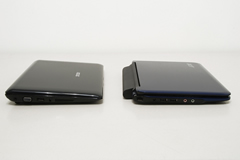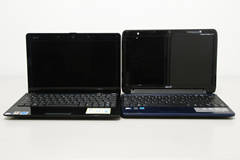Asus Eee PC 1001HA Impressions
From the outside the 1101HA looks similar to other modern Eee models, with its recognizable wedge-shape and black plastic lid with the Asus nameplate plastered near the middle. Looking head-on at the unit you would likely miss the two small LED indicators (power and battery) along the bottom right edge of the system. The lid has a slight lip that overhands the front edge which could be bit more pronounced to make it easier to grasp and open.

On the right edge of the system we find a memory card slot (SD/SDHC/MMC), headphone jack, microphone jack, two USB 2.0 ports and an Ethernet port. The back side of the Eee is plain with only the battery compartment visible. Asus scores a design point here as the battery on the 1101HA does not protrude from the rear of the netbook like we have seen on systems such as the Acer Aspire One 11.6". The left side features the DC power input, VGA-out port, another USB 2.0 port, a Kensington Lock port and some cooling vents.
With the lid open it's evident that the 11.6" screen size and bezel used here are leaps and bounds above the tiny 8.9" display we saw on the Eee 904HA. Above the screen are a microphone and 1.3MP webcam. Below it and just above the keyboard on the left is a touchpad key used to turn the touchpad on / off. This is a rather odd placement for such a button but at least there's the option, while on the right is the system power switch.


As you can see from the pictures above it has more or less the same footprint as the Aspire One 751h. However, the latter has more of a consistent shape when looking at it from the side, while Seashell starts out thin and gradually increases in thickness as you follow it near the back of the system.


Asus did a commendable job with the keyboard and layout on the 1101HA. The Control and Function keys are ideally placed, almost every key (with the exception of the right Shift key) is full-size and there is no wasted space. Typing on the Eee PC 1101HA feels solid as its keyboard doesn't have the extreme amount of flex we have seen in other portables, though there is still a little give beneath the keys.
The multi-gesture touchpad on this Eee is unlike any other I have seen on a netbook. Rather than the typical smooth inset pad we are used to, Asus kept the touchpad flush with the wrist rest, using only a series of tiny raised bumps to differentiate the two. This actually looks really sleek and isn't as difficult to adjust to as you might suspect.
The mouse click buttons are a single piece and chrome in color. As I've mentioned before, two separate click buttons would have been better in my opinion, but it seems the single piece design is popular with manufacturers these days as every notebook and netbook I have worked with recently used this same configuration.


Below the wrist rest to the right we find the status light indicators. From left to right: Power, Battery, Hard Drive, Wireless / Bluetooth and Caps Lock.
On the bottom are four rubber feet, two battery release latches, an access panel for the memory and various cooling vents. Unfortunately, there is no easy way to access and replace the hard drive. Two downward-firing speakers are located beneath the front array of vents, and a SIM card slot under the battery compartment. Asus doesn't advertise the latter as a feature, so it may or may not work, but we thought it was worth mentioning.



